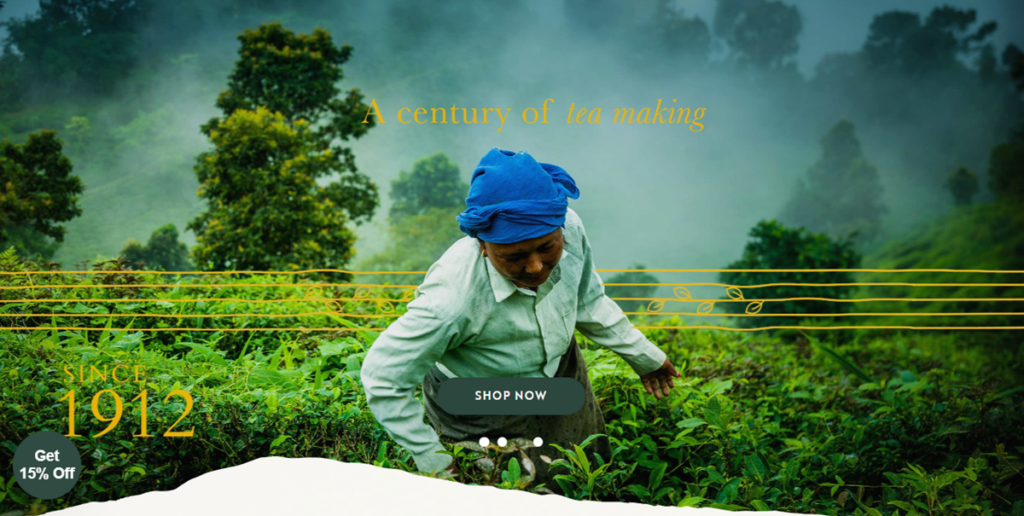Rudra Chatterjee, the dynamic managing director of Luxmi Tea, has expanded and diversified the venerable 30-million-kilo bulk tea producer into direct-to-consumer retail. Luxmi, which operates 25 estates in India and Africa, has shortened the supply chain to deliver fresher tea and now sources herbal infusions and inclusions for blends locally. Chatterjee discusses with South Asia Correspondent Aravinda Anantharaman his vision for rebranding the company as Luxmi Estates.
Listen to the Interview

Fresh Start: Luxmi Seeks to Shorten the Supply Chain
When I last spoke with Rudra Chatterjee, Managing Director of the 110-year-old Luxmi Tea, he discussed a pivot to selling the brand’s offerings direct, as COVID brought more consumers online. Two years later, Luxmi Estates has launched as a significant business vertical. The retail brand offers a range of teas with a subscription program. In this interview, Rudra provides an update on future plans and explains his reasons for rebranding.
See: Will the Pivot Online be the Catalyst the Farm-to-Cup Movement Needs?
Aravinda Anantharaman: It’s been a while since we last spoke. Luxmi Tea has undergone a rebranding. Do talk to us about it.
Rudra Chatterjee: I sense that there are two, or three aspects to it. There are some right-at-the-top marketing aspects to it, but below that, I think there are some layers to it. I always joke that this company was born in some sort of revolution.
So we want to do something new, whether planting new bushes in Africa or in – although it wasn’t part of Luxmi then – Makaibari going organic. So it has a lot of DNA for trying new things. There are a few aspects to it. Number one is more than any other product, that tea is best fresh. But the supply chain isn’t designed to make it as fresh as possible. I think that’s something that we would like to start and we would like many other companies to follow: to make the tea as fresh and have it, using technology, to the customer as soon as possible.
The second aspect, which is I think even more worthwhile, is tea estates have become monocultural spaces but it’s important to grow other herbs. For good or bad, tea is considered a healthy, hot beverage. And so if even a company for a hundred years as tea growers, we have decided to say that, you know, there are amazing places that grow turmeric right next to Addabarie tea estate. And that is a high curcumin level. Frankly, we are not inventing any herb. All the herbs that we are using are the ones that people for hundreds of years know are good for you. So whether it’s turmeric, whether it’s ashwagandha, whether it’s tulsi, whether it is masala chai, lavender, all of these are well-known herbs. But my goal is to source as much as it locally, whether from our own estate or by using farmers near our estate. So African rose from Rwanda, turmeric from Addabarie, we are using Himsagar mangoes, and Gondhoraj Lebu… all these things which are part of our culture. And so nothing that is just pure flavor, these are herbs.
And along with that, we’ve obviously started our website, and one of the focuses is on the estate. And that’s why we call it Luxmi Estates. We are Luxmi Tea Company, that’s the official name of the company, but the brand is Luxmi Estates because I want to say that these teas are from estates. These teas haven’t been bought by someone and packed and sold.
The second aspect is using the hand to say our Lakshmi (Hindu goddess of wealth) is the plucker, and it’s her hand. When I think about the issues in the plantation sector of the tea industry, I think a lot of it is solvable. I’ve said that in an interview with you before if we can sell the tea if I can say that part of the revenue – and that part should keep going up – will go to getting a good impact on the farm. We’ve spent more than ten crore on education within the tea estates (a crore is 10 million rupees, approximately $125,000 in US dollars). We do not have the budget to keep going higher unless we find another source of revenue. So I think all of it comes together, the monocultural aspect, the freshness of the tea, and the lives of workers. I’m quite confident that we will succeed. The reason is, who doesn’t want a better product, fresher, at a fair price? You’ll see the prices are good, and the tea is nicely packaged. And we are not trying to reinvent what is good for you. You know what is good for you. You know turmeric is good for you; you know tulsi is good for you. We will find the best source of it; that is what we are good at – going to the farm and creating the best source, making sure it’s vacuum packed, and it’s shipped to you very quickly. And that’s one reason why we – because we are starting in the winter – we started with the herbal teas. We will add some of the regular teas also, but we wanted to start the regular teas during the first flush and the herbal teas now because this is the time for this kind of herb. So that’s my long overview of what we are trying to do.
Aravinda: When we last spoke, it was also about how you were excited by the conversations you were having with the consumers via social media and the interaction that you were having. And that has really sort of driven a whole shift, isn’t it, in how you’re looking at retail, how you’re looking at direct-to-consumer and all of that?
Rudra: Absolutely. The most important thing is the difference between selling to an invisible hand. You see the prices on the screen, but you hardly know who’s buying, and you don’t know how many steps it will go before the consumer comes. And I had said, I think at that time, even if we can sell 1% of our teas to consumers, we know and hear their opinion and what they like and what they don’t like. It’s great to hear from customers who love that Rugabano* is bright and that it steeps at three minutes, instead of four minutes. And that carries on to this conversation about turmeric and whether green tea will go with it.
I’m open to experimentation. Only I am enough of a purist not to add raspberry flavor or something through the tea because I like the tea as it is. But if it is something that goes with green tea, one plus one is greater than two as it adds something and makes it easily accessible to the customer, and I know that the money is going back to the farm. It is not being taken away from the farm. This is good for the industry. Whether it’s ginger that is produced in Assam, the oranges and lemongrass of Makaibari, or Addabarie for ginger, there’s never the damage that monocultural crops extend to the tea estate. So it’s very good to have many other things along with tea and create other income streams, whether from flowers, honey, or herbs for workers. Like we did, we are doing homestays in the tea estate.
This needs an imaginative solution. It is not a competitive solution. And it’s something that I would welcome everybody to. Because it’s something that we should all do — I’m not saying there should be one big brand — but there should be several big brands. But all of them should be fresh from the farm to the consumer.
Aravinda: How big is retail a part of what Luxmi does now, and what are you expecting to see? And also the addition of the herbal teas themselves. Where did that come from? Was it the whole fallout of covid when the demand for such a kind of tea increased? Or was it that you had access to all these herbs and spices and all of that, and it just made sense to venture into that space? So what was the thinking behind that?
Rudra: A couple of things. One is even much before Covid; growing up on a tea farm, I’m very keen on different kinds of food. So I get like honey from one estate, I get ginger and turmeric, I get red rice, I get peppercorn. So I’ve never thought that tea estates only produced tea. One is the commercial aspect of it, but there are many others. Certainly, during Covid, one thing that changed was I spent all the time in the estate, not in the city, a little bit in Mirzapur, but mostly in the tea estates. In some ways, it was a far more open interaction with everyone there.
Secondly, I think it’s clear, while, you know, people were coming and staying in Makaibari, I could see consumers of Makaibari staying in Makaibari and telling me things that, Why aren’t you doing, you know, mango with this and why aren’t you doing… And we started selling it in Taj, and then we started selling it at the Bagdogra Airport.
From that sample set of few people, it was clear that this is certainly something that customers appreciate. You asked about the percentage of the business; I don’t think I don’t want this to be that all the teas that Luxmi makes should get into our own packages. Not at all. We will continue selling through traditional channels, and we will sell at auctions. We are very, as I said, very grateful for the business. And our prices have also been fine. You might have seen the Assam prices, the Rwanda, and Gisovu. Rugabano is number one and number two in all of Africa. Whether it is Makaibari or the Moran estates, all these are making very, very good teas. But it’s important to think of this as a sustainable solution for the long term. I don’t see why we will not go straight to the consumers with some of the teas. People will mostly continue buying tea from supermarkets, but some might care about something different and something they really care about, and they might want to subscribe to the tea. If they really like strong Upper Assam, they might subscribe to it from us.
So that’s the thought. It’s still evolving, by the way. I can’t say that I’ve figured this out. It’s evolving, and I’m open to customer input and review. The challenge is whether I can ensure we are not weak in the product’s packaging or delivery. Because sometimes it’s so rustic when you do something from the farm. The package doesn’t open properly; it’s dripping or something. I don’t want that. I want people to say, okay, this is a world-class company making a world-class product, but with all the pluses of coming straight from the farm.
Aravinda: What has been the response of the people on your estates – the factory and the fields?
Rudra: Fantastic. I mentioned to you last time that tea planters love talking to people, as you know, you’ve spoken to many of them. So this has given us a whole new set of conversations. And people compete about customer reviews and what they like and, and if there is one review on one website, you’ll see a tea estate manager like taking a photograph of it and WhatsApping it to everybody saying, this is the comment from this customer.
It’s actually great. Also, the more you put sunlight on work conditions in the tea estate, the more change you will get. And it is important that consumers understand there’s a cost to doing it. The money does not come from anyone other than customers. When you’re making the product, every penny we spend on everything comes from the customers who buy our tea, So we would like to make some special tea for really discerning customers, and hopefully, that’ll pay for some better facilities and infrastructure other than introducing the customer to a great product.
Aravinda: So when you look at the Indian industry scenario itself today, given the kind of changes you’ve brought into Luxmi, whether it’s in product innovation, whether it’s in going direct to consumer and in tourism itself, what would you like to see as far as changes in the industry itself go? What do you think it needs in terms of solutions?
Rudra: As a business student, businesses do well when forced to the world and innovate. And tea industry is in such a position today. We have been pushed into the world the way we worked over the last 50 years is clearly not working. Crops are coming down. Climate change is adding costs. There have been incredibly hot days this summer, and then we are having a lot of rain towards the end of the season.
Now tea was an industry that loved routine. Wake up at 5.30 in the morning, go out in the estate, get the plucking rounds in seven days, pack the tea and forget about it, and go back next week. That’s not going to work anymore. You have to keep the discipline of the routine, but you have to add the willingness to change whatever you were doing every now and then. But that’s how, that’s how most of the industry is. That’s how most other industries are. There needs to be some radical changes. For example, I do think that the government and industry should work together and replant forests in some of the tea states, we cannot have this incredibly monocultural environment. And with lot of the forests having gone, the pests have increased, the climate has changed. So I think, there has to be an incentive to do that, from the government. But there can be some earning out of the forests, whether it is from timber or from honey or from fruit or whatever it is.
And, we’ll have to innovate. Like one of the things I always say is we need more women in the industry, living in the tea estates and just rethinking how this business is done. It has been done the same way since maybe the late 1800s and 1900s. There have been some changes. CTC has come, and some others, but the changes have been few and far between. It is important to realize that the industry can provide jobs if it succeeds. And it is important for everybody to want the industry’s success, not just say that we don’t care about the industry’s success. We just want the entitlements out of the industry. That does not work, and that cannot work. I think it’s a big concern when you see many big companies that have been fantastic in their history and how they haven’t been able to continue. These were well-run companies with well-run management, but the 21st-century challenges are new.
Aravinda: I hear a lot of planters say that we’ll do everything you’re asking of us, but it has to be financially sustainable
Rudra: It’s our job to make it financially sustainable. But it’s also our job to think as management, not just ask someone to solve the problems. Every management has a responsibility to keep the business successful, and it cannot be outsourced to anybody.
Aravinda: In your opinion, how has the Indian consumer changed? How has consumption changed, and how has the branding of tea within the Indian market itself? What have you seen change?
Rudra: I think tea is the best product in the world to sell online. Five reasons.
Number one is it’s a habitual product, so that you can subscribe to it. It’s a food product, so you can’t return it. It’s high value to weight product. It is a product you can gift, and it’s a product that doesn’t matter what your religion is or how old you are; it’s a good-for-you product. It’s a healthy product.
Maybe coffee also is an equally good product but, our advantage is that tea has many more varieties. So in terms of being able to have many SKUs, small MOQs is an advantage that tea has over coffee online.
The fresher the product, the better it is. So, not only online, but online straight from the farm.
And also, by the way, it’s the most consumed product in the world when it comes to, you know, the daily consumption of any one product more than salt or anything. So all of that together, it is a product that will make a lot of sense online. But now the thing is, it may evolve significantly. Maybe the last mile may not be online or some other aspects, but I think producers thinking about it are doing the right thing. Many of us will succeed, and many of us won’t. But I think the journey, the trajectory of this business, is to take this business from being treated like a commodity to a very personalized product.
See Luxmi Tea Now Available Online




Luxmi Tea is the official name of the company but the brand is Luxmi Estates because I want to say that these teas are from estates. These teas haven’t been bought by someone and packed and sold.
— Rudra Chatterjee
Aravinda: Right. And in the context of Indian tea, what do you think brand India tea needs right now?
Rudra: Number one: Why isn’t Indian tea available outside India? When I travel abroad, I rarely see packages with Indian tea on them. You see Italian olive oil and Swiss chocolates.
Now you also see cheeses from around the world, but why don’t you see Indian tea? I think the key aspect is that certainly the supply chain to which Indian tea was sold.
The tea’s been sold for a long time. Just like everything else changes, this will also change, and we just have to figure out how it will be. It’s not going to be necessarily the same.
The positive side is there’s this notion that I used to hear that young people don’t drink tea. That’s not true. I don’t know why that gained any credence. I think young people are reducing the consumption of alcohol and sugar drinks, and they’re reducing the consumption of plastic bottles and all of that. Tea is agnostic between hot and cold. Like I tried this 24-hour steep silver tips imperial from Darjeeling, the best tea I’ve had in a long time. And it’s completely different from the tea I usually have, but if it’s great Darjeeling tea, it’ll taste great if you let it bloom and evolve in the right way.
Aravinda: In the context of the larger industry, how do you view the domestic market, and how do you think we can make those connections between the Indian consumers and the Indian tea producers stronger and more effective?
Rudra: I think it has to be through various ways. And there’s not one Indian consumer; there’s not one Indian producer. There are going to be different kinds of Indian consumers and different kinds of Indian producers. There’s one thing that is generally true about the Indian consumer; they will go after authenticity and good value. They will go after freshness, which we need to drive at.
In terms of Indian producers, good tea is appreciated. Every year we can see that. The price difference between the best and the rest of the best and the top decile versus the bottom decile is a V-shaped curve. So that is saying something. And we have to hear what the customer’s saying and then decide what resources do we have to take action to meet the customer’s requirement. There are all kinds of customers for all kinds of producers, so we just have to keep the right connection.
*The Rugabano Tea Factory is located in the Karongi district in Western Province, Rwanda.

A Heritage of Taking the Path Less Traveled
In 1912, when the tea industry was predominantly British, PC Chatterjee founded Luxmi Tea as an Indian movement for self-reliance.
Tea making was characteristically British at the time — sola toupees, burra sahebs, and sundowners. Luxmi was born out of PC Chatterjee’s quest to make Indian tea a tool in the Satyagraha movement and to break the British monopoly.
With a tract of land in Tripura to his name, he began cultivating tea independently, without management agencies or advisors from London. Little did he know the extraordinary legacy he would create and set into motion with Luxmi.
Other members of the Indian freedom movement — Assamese and Bengali students who rebelled against British rule, joined his company, then called Indian Tea and Provisions. What started as an expression of freedom from the British Raj has now come to stand for the freedom of spirit.
— Luxmi Tea Company
Link to share this post with your colleagues
Signup and receive Tea Biz weekly in your inbox.


